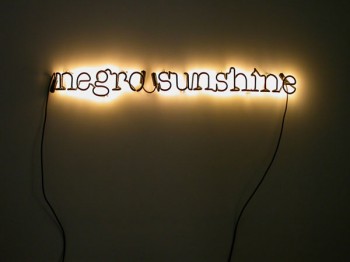
Glenn Ligon, "Negro Sunshine," 2005.
I first saw Glenn Ligon’s Negro Sunshine at Harvard’s Fogg Museum in 2007. And for the rest of the exhibition I was trailed by a staff member to keep me from doubling over in voracious laughter. Culled from Gertrude Stein’s Melanchtha, the piece is representative of Ligon’s signature style that has made him into a chef de intertextual. It was during in his stay at the Whitney’s Independent Study Studio Program in 1985 that conceptualism rushed in. Before that, Ligon’s paintings referenced heavyweights like Willem De Kooning, Robert Rauschenberg, and Cy Twombly. To New Yorkers, Ligon is perhaps best remembered for his contribution to the 1993 Whitney Biennial and his solo show at the museum that year, which cast him as a sardonic artist with an appetite for form — a point Scott Rothkopf sets out to prove in curating Ligon’s comprehensive retrospective Glenn Ligon: AMERICA at the Whitney Museum of Art. A must-see according to every reviewer, this retrospective breakdowns the wit, lust, caution, and skillful erudition of Ligon’s work into an aesthetically pleasing, contextually accessible chronological narrative. Although the sequential take does perhaps delimit the aesthetic possibilities, it provides enough literal space between the decades for once-dismissive critics to contemplate. Walking through, the only thing I really missed was Christina Knight‘s commentary. So I rushed home to ask her about the show, Ligon, and her in-progress dissertation, Performing Passage: Contemporary Artists Stage the Slave Trade.
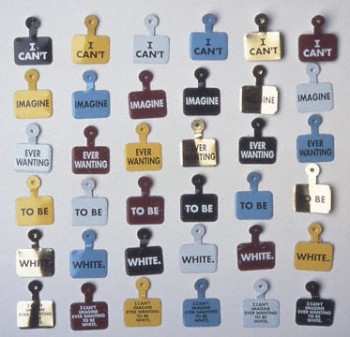
Daniel Martinez, "I can't imagine ever wanting to be white," 1993
Alex Freedman: In a Time Magazine article, Robert Hughes called the 1993 Whitney Biennial “A Fiesta of Whining.” Today, it’s considered a watershed exhibition that laid bare a conglomeration of critical debates fanning the culture wars. How did this installment’s overall criticism stack up?
Christina Knight: Though many critics admitted that the 1993 Whitney Biennial was responding to important trends, much of the criticism voiced exasperation with the show’s relentless focus on race, sex, the AIDS crisis, and other topics familiar to the culture wars. These complaints were couched euphemistically under terms like “multiculturalism” and “political correctness.” Race did play an important role in these debates, though I wouldn’t say that African-American artists were singled out. For instance, Daniel Martinez’s admission buttons drew particular ire: though museum-goers received different words on their badges, together they read, “I can’t imagine ever wanting to be white.” Interestingly enough, Ligon escaped some of this criticism because of his understated, non-polemical style. For example, reviewing Ligon’s work the same year, Washington Post writer Hank Burchard said, “unlike many of his fellows who exhibited in the outrage-us 1993 Whitney Biennial, Ligon has something fairly interesting to say and clever ways of saying it […]. Instead of demanding our attention, Ligon invites it by drawing upon black writers and poets and by assuming a series of ironic identities.” To me, it is interesting that Ligon gets a pass because of his “irony” in spite of the always-political content of his work.

Glenn Ligon, "Malcolm X (Version 1) #1," 2000. Vinyl-based paint, silkscreen ink, and gesso on canvas, 96 x 72 in. (243.8 x 182.9 cm). Collection of Michael and Lise Evans. © Glenn Ligon. Courtesy the artist and Regen Projects, Los Angeles.
AF: I think that’s a salient point — Ligon’s irony has served as criticism’s cornerstone. But in many ways, this mid-career retrospective strives to initiate a re-reading that is more conscientious of Ligon’s formal qualities.
CK: Absolutely. Historically, I think that critics of Ligon have paid special attention to his use of form; here, I am thinking particularly of Darby English’s treatment of Ligon’s work in How to See a Work of Art in Total Darkness. In that sense, Ligon hasn’t been the victim of critical attention that solely focuses on the content (racial, sexual, etc.) of his work. However, I really appreciate the way that Scott Rothkopf’s exhibition catalogue essay reminds us that even critical attention around Ligon’s most famous type of work, the text painting, has failed to acknowledge the breadth of approaches encompassed in that term.
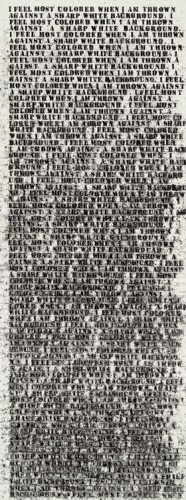
Glenn Ligon, "Untitled (I Feel Most Colored When I Am Thrown Against a Sharp White Background)," 1990. © Glenn Ligon; photograph courtesy Glenn Ligon; photograph by Dennis Cowley.
I bring this up because I think whether Ligon labored over applying each paint-covered stencil to form a word, or applied felt letters to the canvas, or blew glittering, black coal dust over letters has everything to do with the content of the work. For instance, the artist’s gesture of painstakingly repeating phrases from Zora Neale Hurston’s How It Feels to Be Colored Me letter by letter helps to communicate that writer’s own labor to describe her shifting sense of self. Like Ligon’s text, Hurston’s begins with sharp contrasts (“I feel most colored when I am thrown against a sharp white background”) but moves through descriptions of racial conflict towards a definition of self that is mixed and muddled with the “other.” By focusing on the differences in art practices that have heretofore been grouped together, I think this exhibition gives us a chance to think more deeply about how Ligon’s use of form relates to particular cultural interventions.
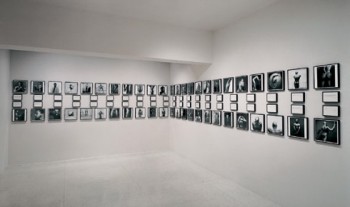
Glenn Ligon, "Notes on the Margin of the Black Book," 1991-93. Solomon R. Guggenheim Museum. Photo: Ellen Labenski.
AF: When I think of cultural interventions, the first thing that comes to mind is his notorious Notes on the Margin of the Black Book. But looking more closely at his oeuvre, there is a repeated strategy of appropriating content from printed matter to intervene, be it from Hurston, Mapplethorpe, coloring books, or criticism.
CK: I do think that the pieces included in Glenn Ligon: America make important interventions in that regard. Notes on the Margin of the Black Book jumps in the melee surrounding Mapplethorpe and his obscenity hearings, but also does a remarkable job of bringing together a patchwork of voices that made up the critical and popular landscape of the early 90s. The beauty there is not simply in the appropriation, but in the arrangement of different perspectives into a truly discordant, even cacophonous conversation. That’s what makes it feel so true to its moment. As for the Coloring series, the appropriation of those coloring book images allows for Ligon’s sense of humor to shine through. Though the image with Malcolm in clown make-up is probably the most iconic, I have a soft spot for the woman with the day-glo orange afro in Sun (version 2) and the blond-haired Isaac Hayes with the platinum chain in Isaac Hayes (version 1). Here, the use of color and styling feels so soulful to me that the “joke” of those pieces seems to be that white kids in Minnesota created them.
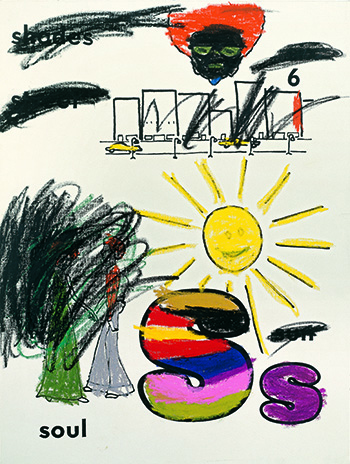
Glenn Ligon, "Sun (Version 2) #1," 2001. Silkscreen ink, oil stick, and gesso on canvas, 48 x 36 in. (121.9 x 91.4 cm). Collection of Eileen Harris Norton. © Glenn Ligon. Courtesy the artist and Regen Projects, Los Angeles.
AF: In your dissertation, you’ll be writing extensively on To Disembark, a work that strategically scatters replications of the box Henry “Box” Brown used to mail himself to freedom filled with music, surrounded by runaway slave posters, and slave narrative frontispieces. Do tell…
CK: Ligon is one of four artists that I’ll be discussing in my dissertation; each worked in close proximity to the Reagan era and its racial backlash, and each engaged with imagery from the Middle Passage. In some ways, Ligon references the Middle Passage in a very subtle way with To Disembark. The title alone evokes the slave ship, and the frontispieces and runaway posters confuse things by introducing familiar narratives of antebellum slavery rather than the slave trade.
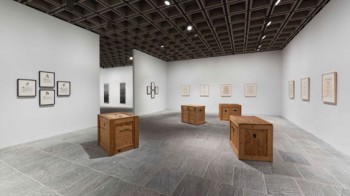
Glenn Ligon, "To Disembark," exhibition view, Whitney Museum of American Art.
The boxes themselves reference Minimalism and its discourses of the phenomenological body, and Ligon embraces the “theatricality,” to use Michael Fried’s term, of the boxes by adding sounds that suggest real black bodies. These include the artist himself reading Henry “Box” Brown’s narrative, “Freedom Song” by Bob Marley, “Strange Fruit” by Billie Holiday, and KRS-One’s militant anthem “Sound of Da Police.” This sonic landscape takes us from the 19th century into the late 20th, and it asks us to make connections between the horrors of slave ships and the other kinds of racial violence that the songs evoke.

Plate from Henry Brown's "Narrative of the Life of Henry "Box" Brown, Written by Himself," 1851
Yet by evoking Minimalism, I think that the work suggests a kind of culpability in museumgoers, not just in helping to constitute art objects through their interactions with them, but in similarly creating black artists. Just as abolitionist audiences encouraged Brown to repeatedly jump out of his box on the 19th-century lecture circuit, so, too, must the black artist “perform” his racial pain for the spectator. In short, the Middle Passage is an apt metaphor, not just because the body of the museumgoer becomes racially charged, but because the idea of slave ships shifts our focus to the flows of power that have shaped black identity since the first slave ship disembarked in the New World. During the 90s, when the piece premiered, To Disembark surely also evoked mainstream politicians (like North Carolina Senator Jesse Helms) who, in their disavowal of racial and sexual difference, helped keep those categories in constant circulation.
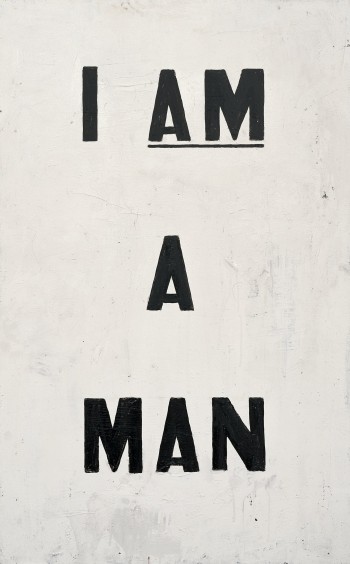
Glenn Ligon, "Untitled (I Am a Man)," 1988. Oil and enamel on canvas, 40 x 25 in. (101.6 x 63.5 cm). Collection of the artist. Photograph by Ronald Amstutz. © Glenn Ligon.
AF: Could you mention an artist influenced by Ligon’s work who you think we should be looking at?
CK: One particularly poignant homage is a series by Hank Willis Thomas called I Am a Man (2008). It addresses and deconstructs the same signage from the sanitation workers strike that Ligon takes on in Untitled (I Am a Man), but it also gestures to the differences between these two generations of artists: Ligon reproduces the sign wholesale (if in a painterly fashion), while Thomas playfully splices and rearranges the sign’s words to find new serendipitous meanings.
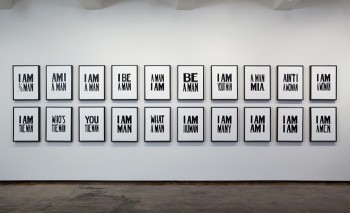
Hank Willis Thomas, " I Am a Man," installation view, 2009. Courtesy Jack Shainman Gallery.
Glenn Ligon: AMERICA is on view at the Whitney Museum until June 5, 2011. The exhibition will travel to the Los Angeles County Museum of Art in Fall 2011.
Christina Knight is a doctoral candidate in Harvard’s Department of African and African American Studies with a secondary field in History of Art and Architecture. She received her BA with honors from Stanford University in Interdisciplinary Studies in the Humanities in 2005. She is interested in the connection between embodied practices and identity. Her current research focuses on representations of the Middle Passage in contemporary American visual art and performance.




Pingback: Open Enrollment | The Art of Close Looking | Art21 Blog
Pingback: Artists & Designers Using Type | Art 200 — Kevin Duffy
Pingback: Presentation 7-12-2013 | hannafiseha's Blog